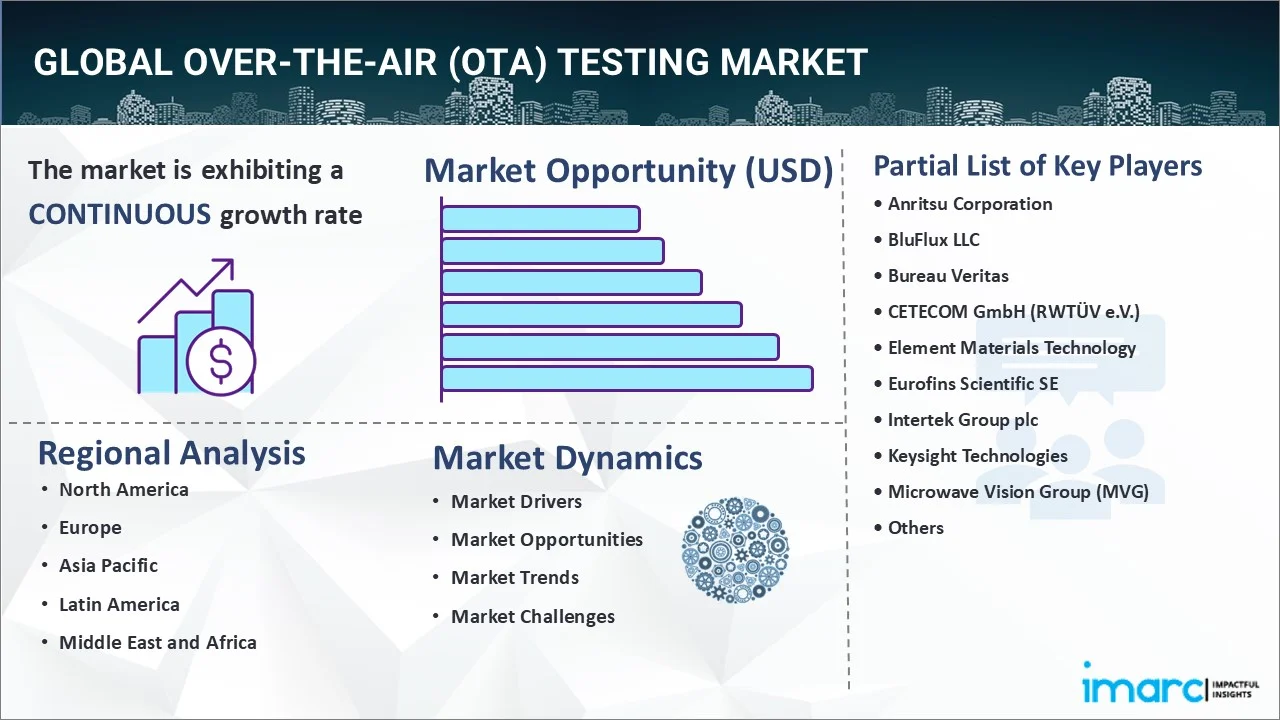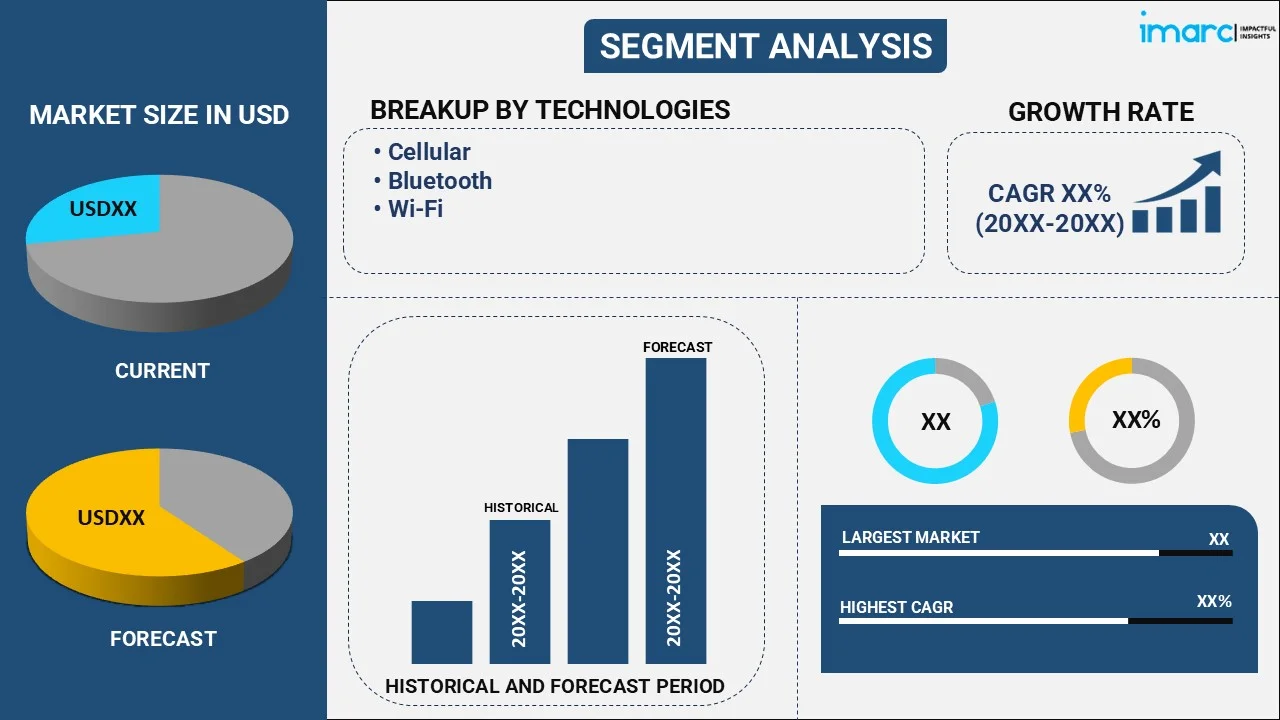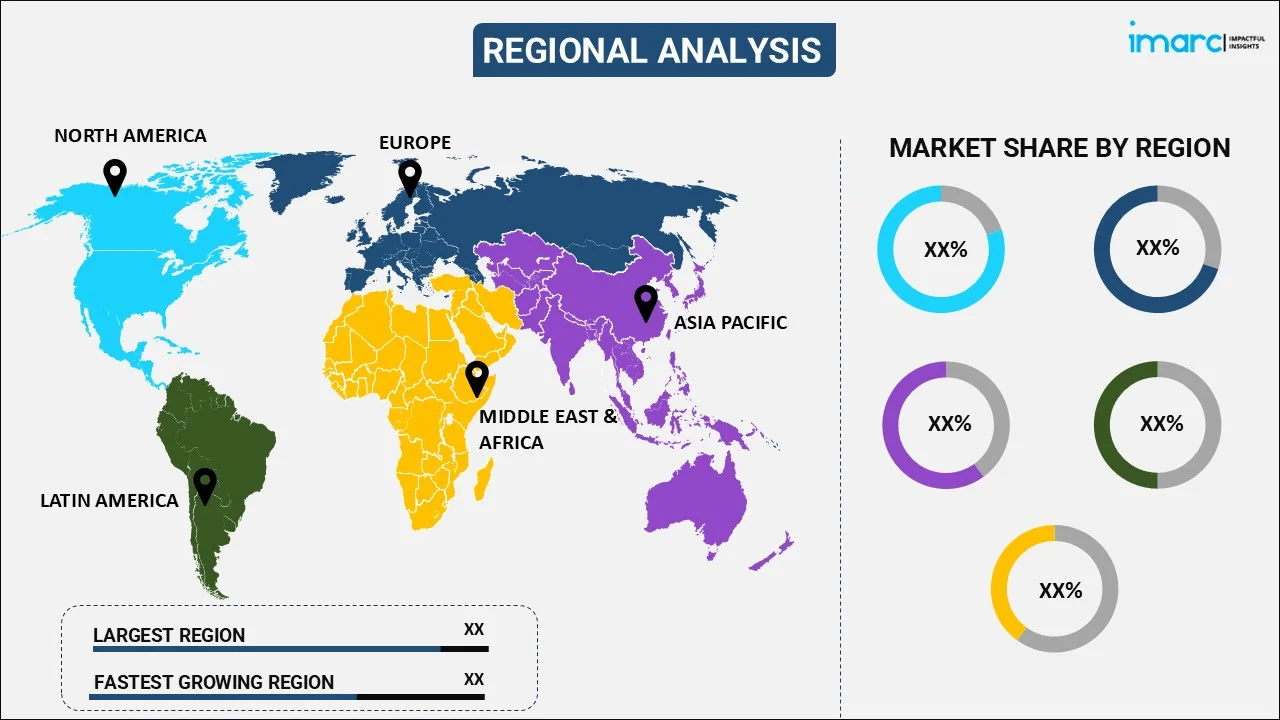
Over-the-Air (OTA) Testing Market Report by Technology (Cellular, Bluetooth, Wi-Fi), Application (Mobile Payment System, Home Automation, Utilities Management System, Traffic Control System, and Others), Industry Vertical (Aerospace and Defense, Consumer Electronics, Automotive, Logistics and Transportation, Healthcare), and Region 2025-2033
Market Overview:
The global over-the-air (OTA) testing market size reached USD 2.6 Billion in 2024. Looking forward, IMARC Group expects the market to reach USD 4.8 Billion by 2033, exhibiting a growth rate (CAGR) of 6.94% during 2025-2033. The rising complexities in wireless networks, expansion of the Internet of Things (IoT) ecosystem, and increasing utilization of smartphones, tablets, wearables, computers, and smart home appliances are some of the major factors propelling the market.
|
Report Attribute
|
Key Statistics
|
|---|---|
|
Base Year
|
2024
|
|
Forecast Years
|
2025-2033
|
|
Historical Years
|
2019-2024
|
|
Market Size in 2024
|
USD 2.6 Billion |
|
Market Forecast in 2033
|
USD 4.8 Billion |
| Market Growth Rate 2025-2033 | 6.94% |
Over-the-air (OTA) testing is a method related to wireless technology evaluation. It comprises the assessment of wireless devices, such as smartphones, the Internet of Things (IoT) devices, and connected vehicles for their performance, functionality, and compliance with standards, all conducted remotely and wirelessly. It evaluates several aspects, such as signal strength, data throughput, antenna efficiency, and electromagnetic compatibility, to ensure optimal wireless connectivity and user experience. It simulates real-world usage scenarios and enables a comprehensive assessment of the capabilities of devices across various conditions.

At present, the rising focus on enhanced user experience and avoiding potential security vulnerabilities is supporting the growth of the market. Besides this, the increasing emergence of fifth generation (5G) technology, along with the rising demand for high-speed internet services, is strengthening the growth of the market. In line with this, the growing demand for OTA testing in connected vehicles and autonomous driving technology in assessing the communication capabilities of these vehicles and ensuring safe and reliable connectivity for features, such as infotainment, navigation, and vehicle-to-vehicle communication, is positively influencing the market. Apart from this, the increasing adoption of OTA testing to enable remote monitoring and management of devices and minimize the need for physical access for updates and diagnostics is offering lucrative growth opportunities to industry investors.
Over-the-Air (OTA) Testing Market Trends/Drivers:
Rising utilization of wireless devices
The rising demand for numerous wireless devices, such as smartphones, laptops, personal computers (PCs), wearables, tablets, and smart home appliances, is contributing to the growth of the market. In addition, consumers are increasingly relying on these devices for communication and various tasks. People are preferring enhanced connectivity and optimal performance to achieve improved productivity. Furthermore, the emergence of fifth generation (5G) technology provides increased speed and connectivity. However, it also presents complex challenges due to higher frequencies and diverse network architectures. OTA testing addresses these challenges by evaluating the ability of devices to function seamlessly within the new 5G landscape. Manufacturers and service providers are ensuring that their devices not only support 5G but also deliver enhanced benefits to consumers.
Increasing complexities in wireless networks
The complex nature of modern wireless networks comprises multiple frequency bands, advanced modulation schemes, and complicated antenna designs, that require rigorous testing. In addition, OTA testing becomes necessary in assessing the ability of a device to navigate complexities effectively. Moreover, stringent industry standards are implemented by several organizations to mandate specific performance benchmarks for wireless devices. Apart from this, OTA testing ensures that these devices meet the standards and enhances compatibility across the wireless ecosystem. Furthermore, manufacturers and developers rely on this testing method to guarantee the adherence of devices to industry norms and to prevent any potential issues, which is supporting the growth of the market.
Expansion of the Internet of Things (IoT) ecosystem
The increasing utilization of a diverse range of devices from wearables and home automation systems to industrial sensors due to the expansion of the Internet of Things (IoT), is contributing to the growth of the market. In line with this, these devices communicate wirelessly and often interact with each other with seamless connectivity and reliable performance. OTA testing addresses the unique challenges posed by the IoT, such as the need for devices to function in various environments and maintain energy efficiency. Apart from this, the reliability ensured by OTA testing is crucial in maintaining the growth of the IoT market. Manufacturers and IoT developers prioritize delivering products that function reliably and consistently across different use cases and scenarios. The over-the-air (OTA) testing market size is expected to expand significantly as manufacturers and developers increasingly adopt OTA solutions to ensure seamless performance, reliability, and energy efficiency for a growing range of IoT devices.
Over-the-Air (OTA) Testing Industry Segmentation:
IMARC Group provides an analysis of the key trends in each segment of the global over-the-air (OTA) testing market report, along with forecasts at the global, regional and country levels from 2025-2033. Our report has categorized the market based on technology, application and industry vertical.
Breakup by Technology:

- Cellular
- Bluetooth
- Wi-Fi
Cellular represents the largest market segment
The report has provided a detailed breakup and analysis of the market based on the technology. This includes cellular, Bluetooth, and Wi-Fi. According to the report, cellular represented the largest segment. Cellular technology comprises evaluating the performance of wireless devices, such as smartphones and tablets, across different generations of cellular networks like third generation 3G), fourth generation (4G) LTE, and fifth generation (5G). This testing focuses on critical parameters, such as signal strength, data transfer speeds, and network handover efficiency. Moreover, it ensures that devices maintain consistent connectivity and data transmission quality under varying network conditions. Manufacturers and service providers rely on cellular OTA testing to validate the ability of the devices to deliver seamless connectivity and enhance user experiences across diverse network environments.
Breakup by Application:
- Mobile Payment System
- Home Automation
- Utilities Management System
- Traffic Control System
- Others
Mobile payment system accounts for the majority of the market share
The report has provided a detailed breakup and analysis of the market based on the application. This includes mobile payment system, home automation, utilities management system, traffic control system, and others. According to the report, mobile payment system represented the largest segment. Mobile payment systems involve assessing the performance and security of mobile devices used for contactless payments and digital wallets. It evaluates the ability of the device to securely transmit payment data over wireless networks and ensure encryption protocols. This testing validates seamless communication between mobile devices and point-of-sale (POS) terminals and verifies that transactions occur accurately. OTA testing assists in enhancing user trust and safeguarding sensitive financial information. It also aids in maintaining the integrity of mobile payment systems and assuring both businesses and consumers that their transactions are secure, reliable, and resistant to potential threats.
Breakup by Industry Vertical:
- Aerospace and Defense
- Consumer Electronics
- Automotive
- Logistics and Transportation
- Healthcare
The report has provided a detailed breakup and analysis of the market based on the application. This includes aerospace and defense, consumer electronics, automotive, logistics and transportation, and healthcare.
In the aerospace and defense industry, OTA testing plays a vital role in ensuring the reliability and resilience of communication systems within aircraft and defense equipment. This involves evaluating the performance of devices in challenging electromagnetic environments and extreme conditions. OTA testing verifies that communication systems maintain connectivity, data integrity, and security, which are crucial for mission-critical operations. In addition, the rising demand for OTA testing in the aerospace and defense industry for maintaining operational efficiency and safety is propelling the growth of the market.
In the consumer electronics sector, OTA testing is integral for assessing the connectivity and performance of devices like smartphones, tablets, wearables, and smart home appliances. This testing ensures that devices meet user expectations by providing consistent wireless connectivity, optimal data speeds, and reliable functionality across diverse usage scenarios. Apart from this, it validates that devices seamlessly connect to Wi-Fi, cellular networks, and other wireless technologies to enhance user experiences and satisfaction.
Automotive OTA testing evaluates communication systems within vehicles and ensures functionalities, such as infotainment, vehicle-to-vehicle (V2V) communication, and telematics. In addition, it guarantees that wireless systems function reliably and securely to enhance safety, navigation, and user experience. Moreover, the rising adoption of OTA testing in autonomous vehicles is strengthening the growth of the market.
Breakup by Region:

- North America
- United States
- Canada
- Asia-Pacific
- China
- Japan
- India
- South Korea
- Australia
- Indonesia
- Others
- Europe
- Germany
- France
- United Kingdom
- Italy
- Spain
- Russia
- Others
- Latin America
- Brazil
- Mexico
- Others
- Middle East and Africa
North America exhibits a clear dominance, accounting for the largest over-the-air (OTA) testing market share
The report has also provided a comprehensive analysis of all the major regional markets, which include North America (the United States and Canada); Asia Pacific (China, Japan, India, South Korea, Australia, Indonesia, and others); Europe (Germany, France, the United Kingdom, Italy, Spain, Russia, and others); Latin America (Brazil, Mexico, and others); and the Middle East and Africa. According to the report, North America accounted for the largest market share.
North America held the biggest market share due to continuous advancements in wireless communication. In addition, the rising adoption of various electronic devices among individuals is strengthening the growth of the market in the region. Besides this, the increasing demand for OTA testing to ensure the seamless integration of devices within the new network landscape is offering a positive market outlook. In line with this, the rising adoption of automotive technologies is supporting the growth of the market in the North America region.
Competitive Landscape:
Major players in the industry are investing in various testing methodologies and equipment to evaluate devices under diverse real-world conditions. This includes testing devices in different environments, signal strengths, and interference scenarios to replicate user experiences accurately. In addition, they are focusing on testing devices for their compatibility and performance within these advanced networks. They are also ensuring that devices can harness the full potential of 5G technology. Apart from this, key players are tailoring their services to meet the specific needs of different industries, such as automotive, aerospace, consumer electronics, and healthcare, by providing industry-specific testing protocols and scenarios to ensure accurate evaluation.
The report has provided a comprehensive analysis of the competitive landscape in the market. Detailed profiles of all major companies have also been provided. Some of the key players in the market include:
- Anritsu Corporation
- BluFlux LLC
- Bureau Veritas
- CETECOM GmbH (RWTÜV e.V.)
- Element Materials Technology
- Eurofins Scientific SE
- Intertek Group plc
- Keysight Technologies
- Microwave Vision Group (MVG)
- Rohde & Schwarz GmbH & Co KG
- SGS S.A.
- UL Solutions
Recent Developments:
- October 2024: VIAVI Solutions launched the VALOR Open RAN Testing Facility in Chandler, Arizona, offering over-the-air (OTA) testing services for Open RAN interoperability, performance, and security. Funded by a US NTIA grant, the facility provides automated, on-demand testing to accelerate Open RAN adoption and support new entrants.
- October 2024: BMW Group announced that it had reached a milestone of 10 million over-the-air (OTA) software updates, with the capability now extended to all brands, model series, and drive types. This innovation, which began five years ago, allows customers to update vehicle software remotely, enhancing comfort, safety, and features. The upcoming updates include new model-specific features like Silent Mode and a virtual "Curve Ahead View."
- August 2024: XPENG launched the Tianji XOS 5.2 OTA upgrade globally, enhancing its Smart Cockpit and Intelligent Driving features. The update, which followed a 28-day beta testing phase with global user feedback, includes features like a split-screen view for better user experience. XPENG also held a User Salon event in Denmark to further engage with customers and refine future updates.
- August 2024: BSNL launched a 4G and 5G-ready over-the-air (OTA) and Universal SIM (USIM) platform, developed with Pyro Holdings. This platform enables subscribers to select mobile numbers and replace SIM cards remotely, without geographical limitations. The rollout began in Chandigarh and supports BSNL's network upgrades to 4G and 5G, with a disaster recovery site in Trichy.
- March 2024: ETS-Lindgren and Keysight Technologies announced the first Over-the-Air (OTA) test solution for equipment that enables narrowband non-terrestrial networks (NB-NTN). This solution enables the testing of devices that use satellite-based cellular communications, enhancing coverage for remote areas. The collaboration will help ensure NTN devices meet performance standards and regulatory requirements.
Over-the-Air (OTA) Testing Market Report Scope:
| Report Features | Details |
|---|---|
| Base Year of the Analysis | 2024 |
| Historical Period | 2019-2024 |
| Forecast Period | 2025-2033 |
| Units | Billion USD |
| Scope of the Report | Exploration of Historical and Forecast Trends, Industry Catalysts and Challenges, Segment-Wise Historical and Predictive Market Assessment:
|
| Technologies Covered | Cellular, Bluetooth, Wi-Fi |
| Applications Covered | Mobile Payment System, Home Automation, Utilities Management System, Traffic Control System, Others |
| Industry Verticals Covered | Aerospace and Defense, Consumer Electronics, Automotive, Logistics and Transportation, Healthcare |
| Regions Covered | Asia Pacific, Europe, North America, Latin America, Middle East and Africa |
| Countries Covered | United States, Canada, Germany, France, United Kingdom, Italy, Spain, Russia, China, Japan, India, South Korea, Australia, Indonesia, Brazil, Mexico |
| Companies Covered | Anritsu Corporation, BluFlux LLC, Bureau Veritas, CETECOM GmbH (RWTÜV e.V.), Element Materials Technology, Eurofins Scientific SE, Intertek Group plc, Keysight Technologies, Microwave Vision Group (MVG), Rohde & Schwarz GmbH & Co KG, SGS S.A., UL Solutions etc. |
| Customization Scope | 10% Free Customization |
| Post-Sale Analyst Support | 10-12 Weeks |
| Delivery Format | PDF and Excel through Email (We can also provide the editable version of the report in PPT/Word format on special request) |
Key Benefits for Stakeholders:
- IMARC’s report offers a comprehensive quantitative analysis of various market segments, historical and current market trends, market forecasts, and dynamics of the over-the-air (OTA) testing market from 2019-2033.
- The research study provides the latest information on the market drivers, challenges, and opportunities in the global over-the-air (OTA) testing market.
- The study maps the leading, as well as the fastest-growing, regional markets. It further enables stakeholders to identify the key country-level markets within each region.
- Porter's five forces analysis assist stakeholders in assessing the impact of new entrants, competitive rivalry, supplier power, buyer power, and the threat of substitution. It helps stakeholders to analyze the level of competition within the over-the-air (OTA) testing industry and its attractiveness.
- Competitive landscape allows stakeholders to understand their competitive environment and provides an insight into the current positions of key players in the market.
Key Questions Answered in This Report
The global Over-the-Air (OTA) testing market was valued at USD 2.6 Billion in 2024.
We expect the global Over-the-Air (OTA) testing market to exhibit a CAGR of 6.94% during 2025-2033.
The increasing utilization of Over-the-Air (OTA) testing across various industries, such as automotive, transportation, aerospace and defense, telecommunications, etc., as it aids in improving the end-user experience by identifying problematic areas, is primarily driving the global Over-the-Air (OTA) testing market.
The sudden outbreak of the COVID-19 pandemic had led to the implementation of stringent lockdown regulations across several nations, resulting in the temporary halt in certifying certain appliances according to the set standards, thereby negatively impacting the global market for Over-the-Air (OTA) testing.
Based on the technology, the global Over-the-Air (OTA) testing market has been segmented into cellular, Bluetooth, and Wi-Fi. Currently, cellular holds the majority of the total market share.
Based on the application, the global Over-the-Air (OTA) testing market can be divided into mobile payment system, home automation, utilities management system, traffic control system, and others. Among these, mobile payment system exhibits a clear dominance in the market.
On a regional level, the market has been classified into North America, Asia-Pacific, Europe, Latin America, and Middle East and Africa, where North America currently dominates the global market.
Some of the major players in the global Over-the-Air (OTA) testing market include Anritsu Corporation, BluFlux LLC, Bureau Veritas, CETECOM GmbH (RWTÜV e.V.), Element Materials Technology, Eurofins Scientific SE, Intertek Group plc, Keysight Technologies, Microwave Vision Group (MVG), Rohde & Schwarz GmbH & Co KG, SGS S.A., and UL Solutions.
Need more help?
- Speak to our experienced analysts for insights on the current market scenarios.
- Include additional segments and countries to customize the report as per your requirement.
- Gain an unparalleled competitive advantage in your domain by understanding how to utilize the report and positively impacting your operations and revenue.
- For further assistance, please connect with our analysts.
 Inquire Before Buying
Inquire Before Buying
 Speak to an Analyst
Speak to an Analyst
 Request Brochure
Request Brochure
 Request Customization
Request Customization




.webp)




.webp)












